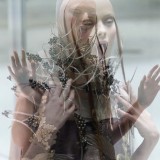Supervisors:
2018
This theoretical project started as an effort to bridge fashion with architecture, while the goal was to be concluded and completed with the last sub-chapter [21]; the introduction to a new proposal and extra-institutional practice. For the achievement of this personal venture two separate but parallel approaches to the subject were followed, the core of which finds the merge of those two fields within the space of the fashion show. The first approach lies in the avoidance of a historical overview. At the same time, due to the lack of references on the architectural practice, and not just on the design of a fashion show, it is considered necessary to consult studies of the past on the parisian and thereby the global position of society towards fashion, and specifically towards the fashion shows of the past, in order to understand and analyze that of today. The rapid pace of the contemporary reality, and the blurred lines between present and future, due to the fact that the reference point is always the future and the present slips to the past before it has even been lived, don’t actually help the contemporary analysis of the fashion shows. However, a rich collection of theoretical material exists, a work of philosophers, journalists, scientists and artists of the previous centuries, which not only helps the analysis of the contemporary fashion shows, but it also reveals secret aspects which couldn’t be visible during the initial research, due to the momentum it has gained.
The second approach lies in a more general way of tackling the field of fashion as a nervous system, between a wide web of information and uncontrolled neurasthenia, which always vibrates and evolves in a parallel way with society. Thus, the very history of the fashion show has been faced as a successive sequence of ecologies, which each and every one being an extension of the previous one and not a reconstruction, suggesting its mode of existence through explosions and alterations of the habit, in order to create a new one.
It is about successive passages reflecting society’s procedures through the fashion show. Through this research of the consolidation of habit and of the evolution of the fashion show, within each ecology, this theoretical project is concluded with the proposal of an extra-institutional practice, it distances itself from the characteristic control and speed of the fashion industry that commands paces, numbers and deadlines towards a pursuit of alternative practises. This pursuit constitutes a proposal of a new mode of existence.
